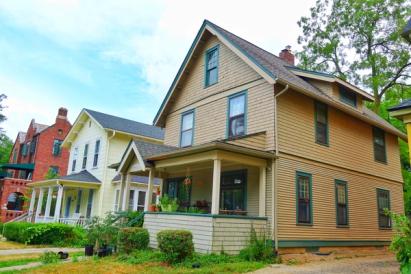What Does Equity Mean and How Does it Work?
Written by:
Lauren Hargrave
Lauren Hargrave
Personal Finance Writer
Lauren Hargrave is a writer from San Diego who focuses on technology, finance, and healthcare. She worked in finance for seven years before pivoting to a career in writing, and now, instead of putting numbers into spreadsheets, she writes about them instead.
See full bio
Fact Checked by:
Dan Silva
Dan is the Vice President of Marketplace Lending at Own Up. Throughout his career, he has held executive leadership positions in the mortgage and banking industry.
See full bio

Your home may have sentimental value as the place where you live and raise your family. But it’s also a tool you can use to build wealth and financial security, as well as help you achieve financial goals. To use your home as a wealth-building tool, you have to understand home equity.
Keep reading for a breakdown on the concept of equity: how equity works, how to build it, and how to eventually use it.
What is Equity?
There are many forms of equity. But equity as it relates to your home is the amount of your home’s market value that you actually own. If you used a mortgage to buy your home, then your home equity is the market value of your home less the balance of your mortgage.
For example, if your home has a market value of $500,000, and the balance of your mortgage is $300,000, then you have $200,000 in equity in your home.
If you’re in the process of buying your first home, the difference between your home’s purchase price and your home loan amount will be your equity in the home. For example, if the purchase price is $500,000, but you put forth a downpayment of $50,000, bringing your home mortgage to $450,000, the amount of equity you will have in your home will be $50,000.
| Item | Amount |
| Purchase Price | $500,000 |
| Down Payment | $50,000 |
| Loan Amount | $450,000 |
| Equity | $50,000 |
As you pay down your mortgage balance, your home equity can increase (as long as your home value stays the same or increases).
How to Build Equity Over Time
Your home equity is not a stagnant thing. It changes over time with mortgage payments, market fluctuations, and even the improvements you make (or the disrepair you allow) to your home. Here are the three ways you can build equity in your home over time.
1. Make Your Mortgage Payments Each Month
Every time you make a mortgage payment, you’re paying down a portion of your loan balance. However, in the earlier months or years of your loan, you may not feel like your loan amount is decreasing that much, and you may not notice significant gains until later years. That’s because of the way home mortgage loans are structured.
Home mortgages with fixed interest rates are structured so the monthly mortgage payments remain the same throughout the term of the loan. But earlier on in the home loan term, the loan balance is typically still high, so the interest charged on that balance will also be high. Therefore, in the beginning, most of the monthly mortgage payment will be allocated to pay for the interest charges with a small amount allocated to pay down the loan balance.
As the loan balance reduces over time, so will the amount of interest that you have to pay. As a result, more of your monthly mortgage payment will begin to allocate toward paying down the principal loan balance.
In a nutshell, the longer you pay your mortgage payments, the faster you can pay down your loan and the more equity you can build.
2. Home Appreciation in Your Area
The market value of your home is the value it would appraise for. As the value of your home – or market value –increases, so will the amount of equity that you have.
To determine home values, appraisers look at recent sales of comparable properties in the area in terms of size, age, and amenities, and use those benchmarks, like price per square foot, to determine the market value of your home.
Many factors can affect housing prices in your area, including wage growth, supply, construction costs, and population growth or decline. But generally speaking, the national average for home appreciation in the U.S. is 3% per year (although home prices can go up and down over the course of many years).
3. Make Home Improvements that Increase Your Home’s Value
It could be easy to assume that any improvement you make to your home will increase its value. But not all home improvements are created equal. First and foremost, you should maintain your home’s systems like electrical and plumbing, as well fixing any safety issues, as not conducting this upkeep could actually decrease your home’s value.
Outside of this necessary maintenance, there are some home improvements that have a high return on investment (ROI). Home improvements that tend to result in a higher bump to your home’s value than their cost to complete can include HVAC upgrades, garage door replacements, and painting or otherwise maintaining the exterior of your home.
Why Equity Matters
Your home equity is an asset that contributes to your net worth and is a form of savings. The more of your home mortgage balance you pay off and the more your home appreciates in value, the more that asset grows. This asset can be held for future savings, or it can be tapped through different types of loans to accomplish a wide range of goals. Here are some examples.
1. Build Home Equity for Future Financial Stability
If you continue to pay off your mortgage until you own 100% of your home’s value, then you will have a low-cost place to live. You will still be responsible for property taxes, homeowner’s insurance, and general maintenance and upkeep, but you won’t have the additional mortgage payment. This can lower your cost of living, giving you more room in your future budget and more flexibility.
Increasing your home equity can also allow you to cash in on a higher percentage of the value of your home if you sell it. If you’re a retiree on a fixed income, being able to sell your home and downsize, pocketing the difference between your current and future home’s value, can be a way to support your lifestyle in your golden years.
2. Use Your Home Equity to Upgrade Your Home
If you’ve built up your home equity, you can access it through a cash-out refinance, a home equity loan, or a home equity line of credit (HELOC) and use the money for home improvements.
Types of Equity-Driven Opportunities
Below are several types of lending opportunities you can consider using the equity in your home.
- Cash-out refinance: A cash-out refinance is the process through which you would refinance your current first mortgage with a new first mortgage that is larger than your current loan balance. For instance, if your current mortgage balance is $250,000, and your new home valuation is $500,000, you could potentially refinance your current mortgage with a new loan up to $400,000 (80% of your home’s market value). This would leave you with $150,000 to put toward home improvements.
- Home equity loan: If you don’t want to refinance your first mortgage, you could take out a home equity loan. When you take out a home equity loan, you borrow a fixed amount against the equity you’ve built. If you take the above example of a first mortgage balance of $250,000 and a home value of $500,000, you could take out a home equity loan of $150,000 to complete the improvements in your home.
- HELOC: If you would rather borrow money as you need it, you could take out a HELOC. A HELOC is like having a credit card attached to your home equity. Your lender approves a maximum (just like with a credit card), and as you need the money, you draw against your available balance.
- A New Mortgage: You can also use your home equity to buy a more expensive house. If the value of the home is $500,000 and your loan balance is $250,000, you have $250,000 in equity you can put toward a new home. If you took out a home mortgage that was 80% of your new home’s value, with $250,000 in equity, you could potentially purchase a home valued at $1,250,000.
Use Your Home Equity to Achieve Financial Goals
You can also use a cash-out refinance, home equity loan, or HELOC to achieve other financial goals, such as paying down expensive debt (like credit cards), funding the start of a business, paying for school tuition for you or your children, or making other investments like rental properties.
Monitoring Your Home’s Equity
Your home owner’s equity is determined by your home’s current market value and your mortgage balance. To make sure you’re building your home equity fast enough to reach your financial goals, it’s a good idea to check in periodically. You can do this by monitoring your loan balance and estimating your home’s market value.
To estimate your home’s value, you can reference a trusted real estate listing service for recent home sales in your area where the property was comparable to yours in age, size, and amenities. Then take their price per square foot metric and apply it to your home. That could give you a rough benchmark of how much the value of your home has appreciated since you purchased it.
The Bottom Line
Your home equity is an important asset that you can use to build future financial security and wealth, and to reach other financial goals. The best ways you can build home equity are to pay down your mortgage and maintain your home through improvements.


